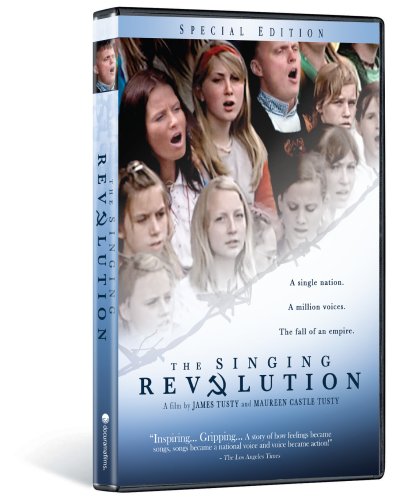"The Singing Revolution"
|
|

This 2009 documentary explores how the little nation of Estonia escaped from the Soviet Union, largely through its cultural heritage of song and literature.
The DVDs “Extras” include several historical clips and side notes. One, “Role of culture under Soviet Occupation,” features interviews with two participants in the Singing Revolution - from the late 80s to the year of independence, 1991 - Marju Lauristin and Artur Talvik. Lauristin is now a professor emerita at the University of Tartu and a former Popular Front leader for the transition from communism to democracy. Artur Talvik was an outspoken participant and leader in the Singing Revolution. Both risked exile to Siberia, or worse, had Russia not been in its own turmoil (or “thaw” if we use Lewin’s change model) during the late 80s.
Lauristin observes that arts of all sorts (culture) were supported by the Soviet/Marxist philosophy. Of course, much of the Soviet notion of culture was about inculcating Lenin, Stalin and Marx. Nevertheless, the arts provided subterfuge for captive people to “argue” ideas, sub rosa. Or even to make trade-offs of propaganda for national identity. Talvik describes how during the 1987 national song festival the choirs sang Soviet “crap” for three days, songs about Lenin and Stalin and Soviet happiness. Then at the end of the concert the choirs – 30,000 participants - erupted into forbidden national songs. In this instance, the KGB allowed it, thinking perhaps that after 3 days of incessant propaganda a little nationalism might be innocuous. More likely, the KGB did not know what to do under the new notion of “glasnost” which supposedly permitted openness and transparency in government and allowed an undefined amount of free speech and expression. As one commentator in the DVD remarks, “The ghost (of freedom) was out of the bottle”; no putting it back. Lauristin describes the phenomenon as springtime; forbidden Estonian flags blossoming like so many flowers.
Estonian audiences knew and were well versed at “reading between the lines.” While the risks were there, especially prior to glasnost, the Russian police were pretty much hapless as to what to do even when they understood the veiled literary or musical reference. (See my Pūt vējiņi: Of individual freedom.)
For example, in a Tallin theater’s 1970s production of Hamlet the curtain went up on a blank stage only decorated with architectural columns. Behind each column was a man, in hiding. The audience applauded; they knew. Those guys were the KGB, sneaking around and spying. And, the play’s line “Something is rotten in the state of Denmark” was immediately applied by the audience to the sorry state of the Soviet Union.
So indeed, culture was a vehicle to get out ideas, to get people thinking, and, eventually, changing its society.
I will use this DVD in teaching about change and about democracy in the workplace, about freedom at work. And, I’d like to work the DVD into a discussion about sustaining large change. How does any organization moving from dysfunction into effectiveness, continue the progress? For Talvik, not long after 1991’s glorious independence theater and films became “highly boring”, there was “nobody to fight,” “the tricky jokes (about the Soviet) were gone.” No longer did theater provide the hidden messages of freedom and the arts went back into their ivory towers. Lauristin explains; during Soviet times Estonian poems were published in runs of 30,000; now editions of 1000 or less sit on store shelves waiting for readers.
More broadly, consider the low voter turnouts in democracies.
Once we reject totalitarianism, what do we want to be? What can any organization do to advance movement and avoid the stagnation implied in the conclusion of a W. H. Auden poem:
“So an age ended, and its last deliverer died
In bed, grown idle and unhappy; they were safe:
The sudden shadow of a giant’s enormous calf
Would fall no more at dusk across their lawns outside.”
@Copyright John Lubans 2014
 John Lubans - portrait by WSJ
John Lubans - portrait by WSJ